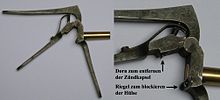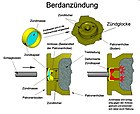Centerfire cartridge
A center fire cartridge , or colloquially center fire ammunition , is a cartridge with center fire ignition . It is cartridge ammunition in which the primer with the primer contained therein is attached centrally in the case base. This is ignited by the centrally guided firing pin . With a few exceptions, all military, hunting and defense handguns today fire center-fire ammunition.
In contrast, the primer of rimfire cartridges is located in the upset case edge and is ignited by a firing pin hitting it. Today, rim ignition can still be found in small-caliber ammunition used in shooting and in small-caliber hunting weapons.
history

In 1812, the Swiss Samuel Johann Pauli received a patent for a two-part cartridge case with a fuse made of fumed mercury in a central ignition hole. The construction itself was very advanced, but still had too many shortcomings. On the one hand, the pressed-in primer was poorly protected against unintentional triggering; on the other hand, the cartridge was not gas-sealed from the cartridge chamber.
The first practically usable unit cartridges with a metal case and built-in percussion cap were the Lefaucheux cartridges with pen ignition, patented by the French gunsmith Casimir Lefaucheux in 1835 . Around the same time, Louis Nicolas Auguste Flobert , also a Frenchman, developed the Flobert cartridge with rimfire ignition, the predecessor of all .22 small caliber cartridges , which was further developed by Tyler Henry into the .44 Henry cartridge in 1860 .
In the war of 1870/71 , Prussia and France still used standard paper cartridges , albeit with internal central fire, in their breech-loaders, the Dreyse needle gun and the Chassepot rifle .
Towards the end of the American Civil War , an American combined both systems. He used a metal case and placed the ignition in the center of the case base, where it was better protected and ignited more safely. In 1864/65 the director of the Frankford Arsenal , Colonel Steven Vincent Benét , developed one of the first centerfire cartridges, the .50-70 Government, for use in modified muzzle-loading rifles for the US Army. Like the rimfire cartridges used at that time, it had a case with a rim made of deep-drawn copper sheet, but the primer was attached centrally on the bottom of the case and was fixed by an inner case. When it was fired, the firing pin suddenly deformed the case base, and the primer in front of it was squeezed and ignited between it and the inner case. The ignition spark was transferred to the black powder propellant charge via holes drilled in the inner sleeve. The inner sleeve was fixed with notches in the outer sleeve.
The .50-70 Government was introduced by the American Army in 1866 and replaced by the .45-70 Government in 1873 . It was used in the Springfield Model 1866 (originally Allin Conversion Model 1866 Rifle ), in modified Sharps military carbines and in Remington rifles modified in the Springfield Armory . Another Benét cartridge used by the army was the .45 Colt for the Colt Single Action Army , but this was replaced early by more modern cartridges.
At around the same time, the Martin center fire cartridge was developed in the United States. It was patented in 1869 and 1871 (US Patent 88 191, 3-23-1869 / 111 856, 2-14-1871). It also had a copper sleeve, which was shaped in a complex process in such a way that the centrally located ignition capsule formed a unit with the sleeve. As with the Benét cartridge, the primer was located inside the case, it was pressed into the powder-side opening of the primer using a perforated, slightly oversized capsule.
Like the Benét cartridge, the Martin cartridge was used in the first American center fire arms. It is known that the first Smith & Wesson No. 3 American revolvers , which still fired the .44 Henry rimfire cartridge, were redesigned for center fire at the request of the American Army Procurement Authority. The new cartridge was called .44 / 100 or .44 American, it was also used in the Colt Army 1860 Richards Conversion .
The Bénet cartridge and also the Martin cartridge had two major disadvantages: the cases made of thin copper sheet were not sufficiently resistant when heavy loads were used, and they warped when the gun was hot and blocked in the cartridge chamber. Another disadvantage was that they couldn't be reloaded. Over time, they have therefore been replaced by more robust cartridges with brass sleeves and primers pressed in from the outside.
The first of such cartridges was the center fire cartridge developed by the American Hiram Berdan with primers pressed in from the outside. In the variant patented in 1866 (US Pat. No. 53,388, 3-14-1866), a copper sleeve was used. The problem was that the sleeve deformed slightly when the primer was pressed in. The cartridge sold well, but brass was still used in 1869. It was patented, with other detail changes, in September 1869 (US Patent 82,587). With this, Berdan had created a cartridge that is still manufactured today.
Around the same time, the Englishman Edward Mounier Boxer developed a cartridge for the Snider-Enfield rifle , the British Army's first breech-loading rifle , in the Royal Arsenal . This cartridge in caliber .577 Snider also had an external primer. He patented the boxer cartridge in England on October 13, 1866 and in the USA (US Pat. No. 91,818, 6-29-1869). Like the Berdan cartridge, the boxer cartridge is still produced today.
In the European armies, possibly for price reasons, cartridges with Berdan ignition were preferred, examples are the 11 × 59 mm R cartridge of the French Gras rifle , the 8 × 50 mm R-Lebel cartridge , the German Ordonnanzpatronen (picture) and the Swiss 7.5 × 55 mm cartridge .
In contrast, the American army took over the boxer cartridge, which was also introduced in England, because it could be reloaded in the field, which was important for troops operating far from civilization. The principle was also retained for modern ammunition, both the .45 ACP pistol cartridge and the .30-06 Springfield rifle cartridge have boxer ignition. This also applies to the civilian market, since boxer cartridges can be reloaded with little effort.
In 1884 Paul Vieille , chemical engineer at the Laboratoire Central des Poudres in Paris, invented a low-smoke powder based on nitrocellulose that emits three times more energy than black powder when burned. This was also a reason to replace the soft copper still used for cartridge cases with more resistant materials such as brass, tombac , and later - due to a lack of raw materials - aluminum and steel.
The fumed mercury previously used for the primer was poisonous and corrosive. It was therefore replaced in the early years of the twentieth century by tetrazene in mixtures ("Sinoxyd sentences").
technology
The common advantage of all central fire ignitions results from the central ignition source, which allows the propellant charge to burn off more evenly than with decentralized ignition (which is used with rimfire cartridges). Even burn causes the increase of the shot precision by the reduction of the dispersion.
Another advantage results from the reusability of cases with center fire ignition. With these, the fired primer can be replaced, while with the cases of rimfire cartridges, the edge is finally compressed by the firing pin. The casings of Berdan and Boxer cartridges can therefore be used several times by reloading . In the case of Berdan cartridges, the fired detonator must be hydraulically pressed out or removed from the rear with a hook-shaped tool; in the case of boxer cartridges, it is ejected from the front through the sleeve and the ignition channel through a pin attached centrally to the tool.
While in the Benét- and Martin cartridges of the priming composition is protected against the ingress of water and oil through the rear imperforate sleeve of the cartridge base of the Berdan and Boxer cartridges must with a suitable lacquer sealed are in order to avoid that, by capillary action of the liquid into the interior Primer penetrates. The color of the paint can also be used to differentiate between different types of cartridges of the same caliber and appearance.
Externally, Berdan cartridges cannot be differentiated from boxer cartridges; the primer cap is one-piece in the former, the anvil is part of the case. In the case of boxer cases, a conically shaped plate is pressed in as an anvil, so that the ignition spark can penetrate the edge of the plate with several milled openings. In both systems, the primer can be separated from the propellant charge with an inserted foil, previously made of tinfoil .
literature
- Bernd Brinkmann, Burkhard Madea, Handbook for Forensic Medicine Volume 1 , p. 601 "Classification of cartridges", Springer Berlin Heidelberg; Edition: 1, ISBN 978-3540002598 (online preview )
Individual evidence
- ↑ Manfred R. Rosenberger, Katrin Hanné: From the powder horn to the rocket projectile: The history of hand fire ammunition Motorbuch Verlag, 1993, ISBN 3613015412 , pp. 70–71









